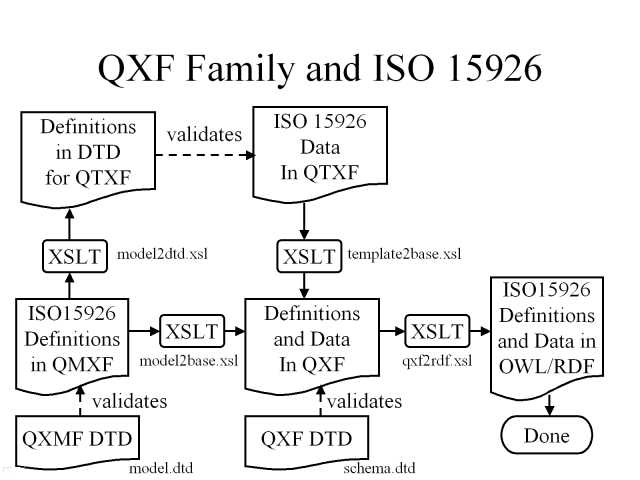TracNav menu
-
IDS-ADI Projects:
- ISO 15926 Primer
- ISO15926 Standard Structure
- IDS-ADI Coordination Structure
- IDS-ADI Infrastructure
- The AVALON Project
- Core Modelers Projects
- Core Implementers Projects
- Core Compliance Project
- Core Methodology Project
- IDS-ADI Matrix Master (login)
- IDS-ADI Matrix 1,2,3 activity
- IDS-ADI Matrix 4 activity
- IDS-ADI Matrix 8 activity
- IDS-ADI Part3 Harmonization
- IDS-ADI BIDG (aka Handover Guide)
- IDS-ADI Proteus Project

POSC-Caesar FIATECH IDS-ADI Projects
Intelligent Data Sets Accelerating Deployment of ISO15926
Realizing Open Information Interoperability
IDS-ADI QXF Project
QXF (for want of a better acronym) stands for Quick XML Format (for ISO15926).
ISO 15926 Payload
The main point of QXF is to provide a rich and explicit means of delivering ISO 15926 payload. It provides a layer between more purpose-driven XML formats for ISO 15926 data, and OWL/RDF. QXF includes a number of these upper layers as well to make this process easier.
Maintain Explicitness One Simple Step from OWL/RDF
QXF is structured in such a way that it transforms into OWL/RDF with a very simple, streaming XSL algorithm - allowing developers to use XSL and other conventional XML tools, without losing explicitness or the link to OWL/RDF.
Upper Layers for Even Greater Simplicity
As a project, it also includes a number of other initiatives: simpler, more human-centric view without losing explicitness and with gaining some XML validation of the structure; and a means of representing complex literals such as lists and tables of floating point values.
Relationship Between Layers
Main Reference Page
The main reference page provides the actual definitions and DTDs, while below we have some quick explanations and (soon) some discussion.
Base QXF
The base QXF structure itself is trivial - it allows representation of n-ary relationships with URIs used to defined resources defined in SPARQL endpoints using OWL/RDF. It is not intended to communicate much to a human, merely to allow early binding implementations to express template data.
Importantly, base QXF supports early binding models placing all of the structural information in the references, much like OWL/RDF.
The Literal DTD
The "literal" DTD provides a means of representing complex literal objects such as 3D points and coefficient tables. Its purpose is to insulate the casual XML user from the singly-linked list implementation of OWL/RDF, which are close to unreadable for humans, but great for machines.
The publish XSL that converts QXF into OWL/RDF also converts this literal format into OWL/RDF, so the literal format is good to use at any level of QXF.
Importantly, literal also supports early binding models.
QTXF
QTXF takes QXF a step further towards a more human-centric XML representation. It does this by "hiding" the explicit URIs in DTDs and using XML element names to reference template definitions and their role names.
QTXF doesn't support early binding models - in an early binding model, data would have to be restricted to a known set of templates. There is ongoing work to define a common set of templates to achieve this.
Template Definition Language
There is also room here for a template definition language that can be transformed to QXF and then to OWL/RDF in much the same way as QTXF.
If the transform can be supported purely with XSL, then it could be a candidate for automated support in the RDS/WIP 2.0 and for manual support in 1.0.
Attachments
- qxf-family.gif (35.1 kB) - added by jbourne 15 years ago.

